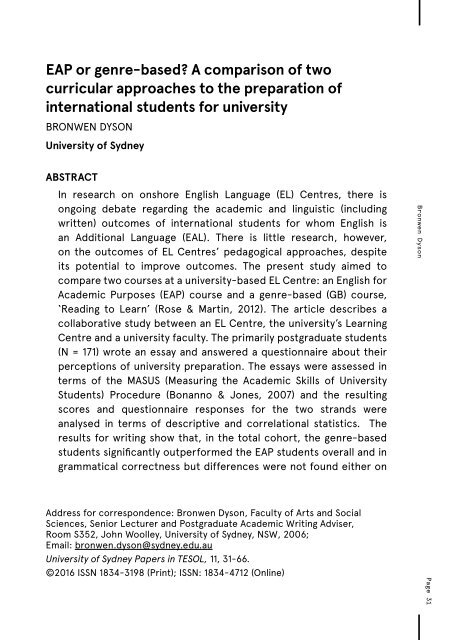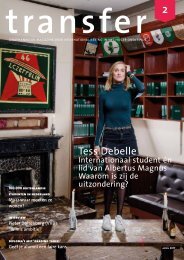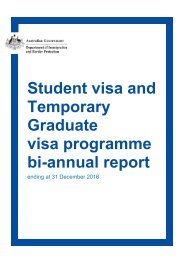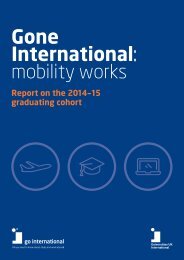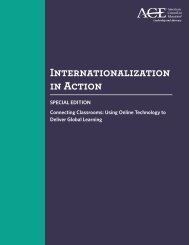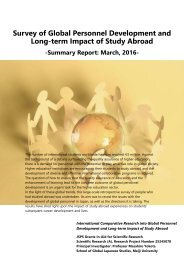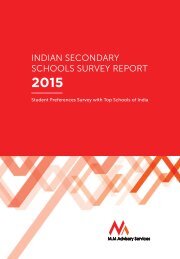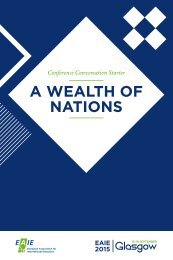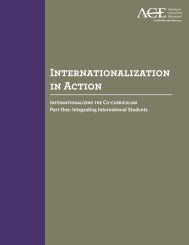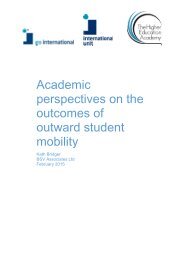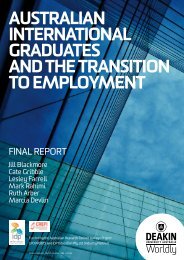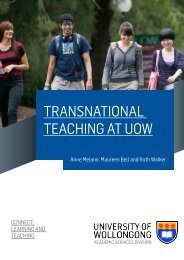Create successful ePaper yourself
Turn your PDF publications into a flip-book with our unique Google optimized e-Paper software.
EAP or genre-based? A comparison of two<br />
curricular approaches to the preparation of<br />
international students for university<br />
BRONWEN DYSON<br />
University of Sydney<br />
ABSTRACT<br />
In research on onshore English Language (EL) Centres, there is<br />
ongoing debate regarding the academic and linguistic (including<br />
written) outcomes of international students for whom English is<br />
an Additional Language (EAL). There is little research, however,<br />
on the outcomes of EL Centres’ pedagogical approaches, despite<br />
its potential to improve outcomes. The present study aimed to<br />
compare two courses at a university-based EL Centre: an English for<br />
Academic Purposes (EAP) course and a genre-based (GB) course,<br />
‘Reading to Learn’ (Rose & Martin, 2012). The article describes a<br />
collaborative study between an EL Centre, the university’s Learning<br />
Centre and a university faculty. The primarily postgraduate students<br />
(N = 171) wrote an essay and answered a questionnaire about their<br />
perceptions of university preparation. The essays were assessed in<br />
terms of the MASUS (Measuring the Academic Skills of University<br />
Students) Procedure (Bonanno & Jones, 2007) and the resulting<br />
scores and questionnaire responses for the two strands were<br />
analysed in terms of descriptive and correlational statistics. The<br />
results for writing show that, in the total cohort, the genre-based<br />
students significantly outperformed the EAP students overall and in<br />
grammatical correctness but differences were not found either on<br />
<strong>Bronwen</strong> Dyson<br />
Address for correspondence: <strong>Bronwen</strong> Dyson, Faculty of Arts and Social<br />
Sciences, Senior Lecturer and Postgraduate Academic Writing Adviser,<br />
Room S352, John Woolley, University of Sydney, NSW, 2006;<br />
Email: bronwen.dyson@sydney.edu.au<br />
University of Sydney Papers in TESOL, 11, 31-66.<br />
©2016 ISSN 1834-3198 (Print); ISSN: 1834-4712 (Online)<br />
Page 31
Page 32 University of Sydney Papers in TESOL<br />
some measures of ‘at risk’ writing or in the cohort recommended<br />
for university. The results for the questionnaire show that the genrebased<br />
students perceived aspects of their academic and language<br />
preparation in a significantly more positive light than the EAP<br />
students. A close look at four students’ writing and the comments<br />
of all students on the questionnaire reveals individual strengths and<br />
weaknesses in both groups. In considering the implications of the<br />
findings for the English Language Intensive Courses for Overseas<br />
Students (ELICOS) industry, the article concludes that, to improve<br />
written outcomes, EL Centres should introduce a genre-based<br />
approach, with fine-tuning to meet the needs of all EAL students.<br />
INTRODUCTION<br />
For international English as an Additional Language (EAL) students, one<br />
of the major ways to enter an Australian university is through the network<br />
of English Language Intensive Courses for Overseas Students (ELICOS).<br />
This Australian-based (onshore) pathway, which develops students’<br />
English language and academic skills, has generally experienced<br />
escalating enrolments in recent years. Following an all-time high in 2009<br />
(138,242), ELICOS enrolments fell to 95,028 in 2011, only to rise again<br />
in 2012 reaching 142,735 in 2015 (Australian Education International,<br />
2012; AGDET, 2015). Given the importance of this route to university,<br />
the literature on ELICOS has focused upon whether or not ELICOS<br />
fosters the linguistic and academic outcomes required for university<br />
(Dyson, 2014; Floyd, 2015; Oliver, Vanderford & Grote, 2012; Terraschke<br />
& Wahid, 2013). There is little research, however, examining how<br />
ELICOS curriculum influences outcomes, although such research could<br />
identify ways to improve the education of international EAL students.<br />
The present study compares two courses at a university-based<br />
ELICOS Centre in terms of student writing and perceptions of linguistic<br />
and academic preparation. One strand was an English for Academic<br />
Purposes (EAP) course and the other was a genre-based (GB) course. In<br />
the context of this study, the GB approach was ‘Reading to Learn’ (Rose<br />
& Martin, 2012; Rose, Rose, Farrington & Page, 2008), a set of strategies<br />
originally designed for Australian Indigenous students, which teaches<br />
reading and writing through particular genres. The article argues that,<br />
compared to the EAP approach, the GB approach provides better
written outcomes and higher levels of student satisfaction, but has not<br />
been sufficiently adapted to the needs of international EAL university<br />
students. The article surveys the study’s context and theoretical<br />
background and then outlines the methodology and findings. It closes<br />
by considering the implications of the results for the ELICOS industry.<br />
THEORETICAL BACKGROUND<br />
This section surveys research on ELICOS (for an overview of the<br />
research, see Table 1). Following this, I discuss the two curricular<br />
approaches relevant to the present study: EAP and GB pedagogy.<br />
English language pathways<br />
In relation to academic outcomes, some research elucidates the<br />
contribution of ELICOS Centres to their graduates’ university success<br />
and perceptions of success.1 Floyd (2015) argues that the academic<br />
acculturation provided by onshore pathways (e.g. skill in giving oral<br />
presentations) led to satisfactory academic outcomes. By comparing<br />
two groups entering university, one via an onshore pathway and the<br />
other via a test such as the International English Language Testing Service<br />
(IELTS), the study found that the early disadvantages of the pathway group<br />
were overcome with time. While the pathway group had lower English<br />
Language (EL) proficiency upon entry and lower Grade Point Averages<br />
(GPAs) in semester one, the groups had similar pass rates in semester<br />
one and a diminished difference in GPA in semester two. Studies of<br />
student perceptions of academic progress found similar results. By<br />
comparing an onshore pathway group with a test group, Terraschke<br />
and Wahid (2013) observed that the pathway group felt more pleased<br />
with their grades than the test group. Dyson (2014) revealed a possible<br />
reason for these results: students attending an EL Centre felt that the<br />
pathway had trained them better in academic than language skills.<br />
In contrast, other findings highlight academic differences between<br />
ELICOS graduates and their peers. From an analysis of one university’s<br />
academic results, Oliver et al. (2012) concluded that the students<br />
submitting EL proficiency evidence other than standardised tests,<br />
e.g. completion of EL pathway courses, displayed more academic<br />
difficulties than those submitting standardised test scores. Likewise,<br />
Dyson (2014) found that, in their first semester, the EL pathway<br />
<strong>Bronwen</strong> Dyson<br />
Page 33
Page 34 University of Sydney Papers in TESOL<br />
graduates received significantly lower grades than peers completing<br />
the same academic subjects. It is also worth noting that in Terraschke<br />
and Wahid (2013) the group which entered university via a proficiency<br />
test attained better academic results than the onshore pathway group.<br />
In relation to linguistic outcomes, some research reveals the influence<br />
of EL pathway courses on English proficiency, including writing proficiency.<br />
According to Terraschke and Wahid (2013), the students with onshore<br />
pathway training felt more prepared for university writing tasks than<br />
those who entered via a test. For example, the pathway group was more<br />
able to identify specific writing skills, such as required essay structure.<br />
Other research is more skeptical about the contribution of EL<br />
pathway courses to improvements in writing. Green’s (2005) comparison<br />
of pathway learners and candidates taking the IELTS Academic Writing<br />
test found improvements at the lower (e.g. 5) but not the higher (e.g.<br />
6) IELTS score bands. Green (2005, p.58) concluded that, “… for<br />
writing at least, the formula of 1 band in 200 hours of intensive study<br />
cannot be supported”. Dyson (2014) illustrates this point by showing<br />
that essays written by EL pathway students displayed high levels of ‘at<br />
risk’ writing, with risk measured by the Measuring the Academic Skills<br />
of University Students (MASUS) Procedure (Bonanno & Jones, 2007).<br />
By examining EL pathway curriculum, some research uncovers<br />
the importance of discipline-embedding for the teaching of writing.<br />
Benzie (2011) reveals that the pathway expected to pass on a<br />
predictable set of skills whereas the discipline expected students<br />
to engage theoretically with existing knowledge. Furthermore,<br />
by analysing outcomes from pathway curriculum, Counsell (2011)<br />
questions the effectiveness of teaching generic writing strategies,<br />
such as revision. The study found that the ex-pathway students did not<br />
always transfer strategies into discipline-specific writing at university.<br />
In sum, the small body of work on ELICOS fails to reach agreement<br />
regarding outcomes. It suggests, nonetheless, that academic and<br />
language skills are both important outcomes but that they may not be<br />
sufficient, particularly early in students’ university studies. While some<br />
research questions the effectiveness of pathway curriculum, there is<br />
little work on the outcomes of ELICOS Centres’ pedagogical approaches.
TABLE 1<br />
Research on English language pathways<br />
Studies Participants Method<br />
Floyd (2015)<br />
Test (N = 134)<br />
EAP (N = 108)<br />
Comparison of academic results &<br />
questionnaire responses (e.g. age,<br />
region) of Testing & EAP students<br />
Terraschke &<br />
Wahid (2013)<br />
Dyson (2014)<br />
Test (N = 12)<br />
EAP (N = 7)<br />
Accounting PG<br />
students<br />
EL Centre<br />
mainly PG<br />
students<br />
(N = 173)<br />
Comparison of Test & EAP students by<br />
semi-structured quarterly interviews.<br />
EAP: 2 prior to entry, 3 post-entry;<br />
Direct Test Entry: 3 post-entry<br />
Analysis of writing, perceptions &<br />
academic achievement<br />
<strong>Bronwen</strong> Dyson<br />
Oliver,<br />
Vanderford &<br />
Grote (2012)<br />
UG & PG NESB<br />
students, 2/3<br />
international<br />
(N = 5, 675);<br />
20.85% of total<br />
enrolment<br />
Comparison of ELP requirements &<br />
overall academic achievement (WAM)<br />
at 1 university<br />
Green (2005)<br />
Test (N =<br />
15,380) Phase 1<br />
EAP (N = 2,476)<br />
Phase 2<br />
Phase 1 & 2 studies of gains made on<br />
IELTS Academic Writing test. Phase 1:<br />
test on 2 occasions<br />
Phase 2: learners at entry & exit of EAP<br />
courses<br />
Counsell<br />
(2011)<br />
Ex-Direct Entry<br />
(N = 4)<br />
Business<br />
Questionnaire (100 items) & interviews<br />
on use of writing strategies<br />
Benzie (2011)<br />
N/A<br />
Comparison of curriculum documents<br />
at EL Centre & Business program<br />
Page 35
Page 36 University of Sydney Papers in TESOL<br />
EAP and genre-based pedagogy<br />
This section turns to the two curricular approaches pertinent to the<br />
present study – EAP and GB pedagogy– and a procedure for assessing<br />
genre control in academic writing.<br />
Research on pathways indicates that EAP is the dominant approach<br />
in ELICOS (Counsell, 2011; Floyd, 2015; Terraschke & Wahid, 2013). EAP,<br />
a branch of English for specific purposes, addresses English language<br />
learners’ purposes for using English in the academic domain (Paltridge<br />
& Starfield, 2013). Hyland (2013, p. 96) clarifies one of the chief ways<br />
in which EAP programs do this: “ESP conceptions of writing focus on<br />
assisting students towards competence in particular target genres”.<br />
This conception of genre is based on Swales and colleagues’ work in<br />
North America (e.g. Swales, 2004), which defines genres as “staged,<br />
structured events, designed to perform various communicative<br />
purposes by specific discourse communities” (Hyland, 2013, p. 98).<br />
Another approach widely used in adult and tertiary contexts, including<br />
with EAL learners (Dreyfus, Humphrey, Mahboob & Martin, 2016), is the<br />
genre pedagogy developed by the research group known as the Sydney<br />
School. The theoretical base of the Sydney School – the meaning-based<br />
theory, Systemic Functional Linguistics (SFL) (Halliday, 2014) – defines<br />
genre as “a staged goal-oriented social process” (Rose & Martin, 2012,<br />
p. 1). Compared to EAP, the Sydney School conceptualises genre more<br />
centrally, generally and linguistically, and encapsulates other dimensions<br />
such as register (Rose & Martin, 2012; cf. Charles, 2013). Guided by<br />
this theorisation of genre, SFL’s applications of genre pedagogy, such<br />
as ‘Reading to Learn’, have created strategies for teaching literacy.<br />
‘Reading to Learn’, for example, involves nine sets of strategies<br />
for reading and writing in three levels (Rose & Martin, 2012, p. 147):<br />
Level 1 Preparing for reading Joint construction Individual construction<br />
Level 2 Detailed reading Joint rewriting Individual rewriting<br />
Level 3 Sentence making Spelling Sentence writing<br />
According to Rose and Martin (2012, p. 147), “The strategies in cycle<br />
2 (‘Reading to Learn’) provide a higher level of support for students to<br />
read the language of curriculum texts with detailed comprehension,<br />
and to use the language they have learnt from reading in their
writing”. Hence, the writing of genres flows from reading them.<br />
An instrument for assessing genre control in tertiary-level academic<br />
writing is the MASUS Procedure (Bonanno & Jones, 2007). MASUS is a<br />
Post Entry Language Assessment (PELA), which diagnoses strengths and<br />
weaknesses in four major areas of university writing, each divided into<br />
sub-criteria (see Appendix for the MASUS criteria for expert raters):<br />
A:<br />
Use of source material - is information retrieval and processing<br />
of data correct and appropriate for the task?<br />
B:<br />
C:<br />
Structure and development of the argument - is the structure<br />
and development of the writing clear and generically appropriate<br />
to the topic and its context?<br />
Academic writing style - does the grammar conform<br />
to the patterns of written academic English<br />
appropriate for the task?<br />
<strong>Bronwen</strong> Dyson<br />
D:<br />
Grammatical correctness - do grammatical errors interfere with<br />
communication of the message?<br />
The MASUS Procedure is well-adapted to assessing university writing<br />
due to its theoretical and empirical advantages. Unlike skill-based PELAs<br />
such as Diagnostic English Language Needs Assessment (DELNA) (Doe,<br />
2014), MASUS focuses on writing within the genres of university disciplines,<br />
such as essays. Research on MASUS has demonstrated, moreover, its<br />
utility, validity and reliability (Erling & Richardson, 2010; Holder, Jones,<br />
Robinson, & Krass, 1999; Scouller, Bonanno, Smith & Krass, 2008).<br />
This survey of the literature elucidates the need to examine<br />
the outcomes of EL pathway curriculum, the potential of EAP<br />
and GB pedagogy for such an investigation and the suitability of<br />
MASUS as a tool for assessing the production of written genres.<br />
Although there are explorations of the role of GB approaches in<br />
EAP (Bruce, 2013), comparisons of EAP and GB approaches are rare.<br />
Page 37
Page 38 University of Sydney Papers in TESOL<br />
RESEARCH QUESTIONS<br />
The present study investigates the following questions:<br />
1. Does the EAP or genre-based approach produce academic<br />
writing which is more appropriate for university?<br />
2. Do students perceive the EAP or genre-based approach as<br />
more effective in developing the academic and linguistic<br />
skills required at university?<br />
THE STUDY<br />
Setting<br />
The study was set in an EL Centre contributing between 600 and<br />
700 primarily postgraduate students per annum to an Australian<br />
university. It was conducted from 2009 to 2010 by a collaborative<br />
team representing the EL Centre, the Learning Centre and a faculty<br />
of the university. This study collected two datasets: the overall<br />
findings and the findings for the two pedagogical approaches used<br />
at the time: an EAP and a GB approach. Dyson (2014) reported<br />
on the first dataset and the present article reports on the<br />
second (for the relationship between these studies, see Figure 1).
FIGURE 1<br />
The relationship between three studies of an EL pathway<br />
2009-2010 study 2014 study (Dyson, 2014) 2016 study<br />
Collected data on 173<br />
EL pathway students’<br />
writing, perceptions<br />
of preparation &<br />
academic progress<br />
at university.<br />
Analysed the data<br />
overall & for the two<br />
curricular strands<br />
(EAP & GB)<br />
Presented findings in<br />
an in-house report<br />
Published the overall<br />
results, on 173 ii EL<br />
pathway students’ writing,<br />
perceptions of preparation<br />
& academic progress<br />
at university<br />
Reanalysed the<br />
original results<br />
for writing &<br />
perceptions of<br />
preparation in<br />
the two curricular<br />
strands (EAP &<br />
GB) & added new<br />
data on individual<br />
students in<br />
the strands<br />
<strong>Bronwen</strong> Dyson<br />
Given the time lapse between the original and the present<br />
study, it is important to highlight the ways in which the data are<br />
relevant to the current teaching and learning context. The EAP<br />
and GB approaches used in 2009 remain current trends in TESOL<br />
(Dreyfus et al., 2016; Paltridge & Starfield, 2013). Moreover, students<br />
required IELTS 6 to enroll in pre-entry courses in 2009 and still do.<br />
Thus, the courses and learners at both points of time are similar.<br />
Curricular approaches<br />
The two types of university preparation courses offered by the Centre<br />
are referred to here as EAP and GB. Whilst recognising the role of<br />
genre in EAP, I refer to only one as GB because, as mentioned above,<br />
this course followed ‘Reading to Learn’ (Rose & Martin, 2012), in which<br />
genre is central. While the EAP course was typical of the Centre’s past<br />
curriculum, the GB course was offered for the first time in year one of<br />
the study. Both courses were 10 weeks in duration – with an optional<br />
five additional weeks for the GB course – and aimed to develop<br />
proficiency to (at least) IELTS 6.5, the minimum university requirement.<br />
The EAP course:<br />
• Required IELTS band 6 or the satisfactory completion of a prior<br />
advanced course which was not IELTS tested;<br />
• Aimed to prepare students for an in-house EL proficiency<br />
Page 39
Page 40 University of Sydney Papers in TESOL<br />
test and develop the English proficiency needed<br />
for academic purposes;<br />
• Structured the curriculum around weekly themes of academic<br />
interest, e.g. Business issues;<br />
• Provided weekly tasks, including the writing of argument<br />
and discussion essays;<br />
• Assessed students by an in-house proficiency test comprising<br />
the four sections of the IELTS academic test; the result was<br />
an IELTS-equivalent score upon which a student’s university<br />
entry was determined.<br />
The GB course:<br />
• Required IELTS band 6;<br />
• Aimed to prepare students for university entry and develop<br />
faculty-like English use;<br />
• Structured the curriculum around ‘Reading to Learn’ and two<br />
core strands: Accounting and Commerce/Arts/Engineering;<br />
• Provided fortnightly task cycles, with half of the weeks devoted<br />
to reading and writing in different academic genres;<br />
• Assessed by continuous and progressive weekly tasks, including<br />
a written diagnostic; the result was an IELTS-equivalent score<br />
upon which a student’s Direct Entry was determined.<br />
Participants<br />
The participants were 171 students - 51% of the total pre-entry<br />
enrolment - who were completing either of the Centre’s pre-entry<br />
courses – EAP or GB – and who consented to participate in the<br />
study (see Table 2 for the major characteristics of the participants).<br />
To briefly sketch the ethics procedure, the study and its materials<br />
were approved by the university’s human ethics committee. Following<br />
this, all students in the pre-entry cohort were given an invitation to<br />
participate, a participant information sheet explaining the research,<br />
and a consent form, all of which were on paper and in plain English.<br />
The participant information sheet explained that normal classes would<br />
be organised for students who did not consent and that participants<br />
may benefit from the research because they would receive
feedback on their writing and would be directed to suitable support.<br />
On the basis of their IELTS-equivalent scores of 6.5 or above,<br />
119 of this group were ‘Recommended’ for university entry and 52<br />
students were not and, hence, stayed at the Centre. The entire<br />
GB group (N = 93) was “Recommended” whereas only a portion of<br />
the EAP students gained this status (Total 78; Recommended 26).<br />
<strong>Bronwen</strong> Dyson<br />
Page 41
TABLE 2<br />
The major characteristics of the participants<br />
Categories Characteristics Units<br />
Level of enrolment Postgraduate 97 %<br />
Gender Male 60 %<br />
Language background Chinese 88 %<br />
Intended faculty Business 84 %<br />
Page 42 University of Sydney Papers in TESOL<br />
Years learning English - 10 years (M)<br />
Months at the pathway - 5.8 months (M)<br />
Last IELTS test (before<br />
entering the Centre)<br />
Overall IELTS score at<br />
end of 10 week course<br />
Overall<br />
Listening<br />
Speaking<br />
Reading<br />
Writing<br />
6.1 (M)<br />
6.2 (M)<br />
5.9 (M)<br />
6.3 (M)<br />
5.7 (M)<br />
7.1 (M)<br />
Instruments and procedure<br />
Two instruments were employed to collect data on the students’ (a)<br />
the MASUS Procedure and (b) a self-report questionnaire.<br />
The MASUS Procedure was adapted to the ELICOS setting to<br />
assess the participants’ written proficiency. In the MASUS Procedure,<br />
students are given a pre-reading and, on the day of the assessment,<br />
asked to respond to the issues raised in this pre-reading by answering<br />
a question (Bonanno & Jones, 2007). In this study, the students were<br />
given a pre-reading on Business Ethics – a required topic at the<br />
pathway – and then, on test day, asked to respond to the issues in the<br />
article by writing an essay (for the task’s instructions, see Figure 2).
FIGURE 2<br />
Instructions for the writing task<br />
1. You have been given an article entitled: Ethical business: Challenges<br />
and the way forward, by Kamel Mellahi and Geoffrey Wood, to prepare<br />
in advance. It is a chapter from Mellahi, K. and Wood, G. (2003) ‘The<br />
Ethical Business: Challenges and Controversies’, pp. 141-147. The article<br />
discusses a range of ethical dilemmas facing businesses today.<br />
2. Read the instructions for the writing task:<br />
The article discusses a range of ethical dilemmas facing business<br />
today. It is essential that managers recognise that they have ethical<br />
obligations not only to their businesses but also to wider society.<br />
Discuss this statement.<br />
3. Then when you are ready, write 1 - 2 pages in the booklet given,<br />
responding to the task. You may refer to your annotated article as well<br />
as your own ideas about the question.<br />
• You have 1 hour to answer the question.<br />
• The time is now ___________ and you will finish at ___________.<br />
• You will be given time checks ten minutes and two minutes<br />
before the end.<br />
• We will now start the test. You may start writing.<br />
The following rationale supported the validity of adapting MASUS – a<br />
PELA – to a pre-entry cohort. Firstly, the majority of the participants<br />
were postgraduates, and hence already at the tertiary-level, and all<br />
were being trained to attain an Australian university’s standard of<br />
writing in the coming semester. Secondly, the researchers believed<br />
that the feedback and support which forms an integral part of the<br />
MASUS Procedure would be useful to the participants. Thirdly,<br />
MASUS is empirically underpinned by EAL data (Scouller et al.,<br />
2008), making it suitable for the pathway context. In retrospect,<br />
one could also observe that MASUS has continued to be trialled on<br />
cohorts other than its Australian, undergraduate base, such as at<br />
the United Kingdom’s Open University (Erling & Richardson, 2010).<br />
The self-report questionnaire was designed to reveal student<br />
perceptions of whether the EL Centre had prepared them effectively<br />
for university participation. The questions were informed by discussions<br />
with pathway graduates and surveys used previously with international<br />
students (e.g. Mullins, Quintrell, & Hancock, 1995). The present study<br />
<strong>Bronwen</strong> Dyson<br />
Page 43
Page 44 University of Sydney Papers in TESOL<br />
focuses on two questions of the questionnaire (6 and 7). In Question<br />
6, the students were asked to rate 10 statements regarding their<br />
preparation on a scale ranging from 1 (Strongly disagree) to 5 (Strongly<br />
agree), with 3 signifying “Don’t know”. These statements were as follows:<br />
(1) The pathway has prepared me to participate effectively<br />
in my university studies;<br />
(2) At the pathway I have learned the academic skills I<br />
need for university;<br />
(3) At the pathway I have learned the types of writing<br />
I need for university;<br />
(4) At the pathway I have improved in my English language proficiency;<br />
(5) At the pathway I have improved in my use of grammar;<br />
(6) At the pathway I have improved in my knowledge of grammar;<br />
(7) As a result of my pathway course/s, I feel confident about<br />
speaking in English at university e.g. giving oral presentations;<br />
(8) As a result of my pathway course/s, I feel confident about<br />
listening to English at university e.g. listening to lectures;<br />
(9) As a result of my pathway course/s, I feel confident about<br />
writing in English at university e.g. writing reports and essays;<br />
(10) As a result of my pathway course/s, I feel confident about<br />
reading in English at university e.g. reading journal articles.<br />
In Question 7, the students were asked to provide reasons for<br />
their answers to Question 6.<br />
These instruments were employed with the entire cohort towards<br />
the end of their pathway courses. In the adapted form of MASUS, a<br />
week prior to the test day the students were given the pre-reading<br />
and on test day they were asked to respond to the issues in the<br />
pre-reading by writing an essay. On the test day, the students<br />
completed the essay and questionnaire, with teachers from the EL<br />
Centre as invigilators. The invigilators stayed in the rooms while the<br />
essay was written and then, to avoid influencing its outcome, left<br />
the room while students completed the questionnaire. The essay<br />
took one hour and the questionnaire took approximately 20 minutes.
Data analysis<br />
The data analysis of the essays comprised two main steps: the marking<br />
and statistical analysis. Coordinated by the university’s Learning<br />
Centre, the marking procedure aimed to be as reliable as possible<br />
by employing experienced markers, providing them with a briefing<br />
and instigating a standardisation process. The briefing instructed the<br />
markers in how to use the MASUS criteria for expert raters. Specifically,<br />
the markers were asked to assess the essays in terms of the four<br />
obligatory MASUS Areas (A, B, C and D), to allocate an ‘A’ (appropriate)<br />
or ‘NA’ (not appropriate) for each sub-criterion and, from this, an Area<br />
rating (out of 4, with 1 signifying ‘poor’ and 4 signifying ‘excellent’)<br />
and an overall rating (out of 16). For the standardisation process,<br />
the marking coordinator prepared a set of descriptors for the four<br />
Areas and their sub-criteria (for more details, see Dyson, 2014).<br />
Statistical analyses were conducted on the participants’ MASUS<br />
scores and responses to the questionnaire. The MASUS scores were<br />
divided according to whether the students were in the EAP or GB<br />
group and ‘Recommended’ or ‘Not Recommended’. The number of<br />
‘at risk’ scripts were computed, with ‘at risk’ defined as 10 or less for<br />
an overall mark and 2 or less for an Area. The questionnaire responses<br />
of the EAP and GB students to Question 6 (rate ten statements) were<br />
analysed but without further division since the anonymous nature<br />
of the questionnaires did not permit division into Recommended<br />
and Not Recommended cohorts. The data on Question 7 (give your<br />
answer for your ratings) were only analysed to locate examples for<br />
the following rating bands: 1 or 2 (Strongly disagree or disagree),<br />
3 (Don’t know), 4 or 5 (Agree or strongly agree). Descriptive and<br />
correlational analyses were conducted on the quantitative data.<br />
Note that Cohen’s d test was only applied to the differences which<br />
were statistically significant according to the analysis and the<br />
analyses of t-test assumptions were done only on the total cohort.<br />
I also conducted an analysis of the essays written by four<br />
individual students in the total cohort. While this may seem a small<br />
sample, these four texts were representative of the entire cohort<br />
because they were selected according to the following criteria:<br />
• The writers of the texts had a similar language background to<br />
<strong>Bronwen</strong> Dyson<br />
Page 45
Page 46 University of Sydney Papers in TESOL<br />
the entire cohort (Mandarin and/or Cantonese);<br />
• The writers of the texts intended to enrol in the main target<br />
discipline of the entire cohort (Economics/Business);<br />
• The writers of two of the texts had attended the EAP course;<br />
• The writers of the other pair of texts had attended<br />
the GB course;<br />
• One member of each of the course-based pairs was<br />
Recommended for university whereas the other was<br />
not Recommended;<br />
• One text from each of the course-based pairs had an overall<br />
score of 11 (i.e. just above the ‘at risk’ criterion of 10 or less<br />
and Mean score for the GB group iii );<br />
• One text from each of the course-based pairs had an overall<br />
score of 9 (i.e. just below the ‘at risk’ criterion of 10 or less<br />
and Mean score for the EAP group);<br />
• The pairs’ ‘at risk’ and ‘not at risk’ texts resembled the Mean<br />
distributions of Areal scores in the total cohort, which was<br />
more possible in Areas C and D than A and B.<br />
The analysis of the four texts aimed to illustrate group and<br />
individual differences in writing. It was based on the ratings each<br />
essay received for the four obligatory MASUS areas and their<br />
sub-criteria. Guided where possible by the raters’ comments<br />
and marks, I looked for examples which supported the ratings.<br />
RESULTS<br />
This section presents the findings for the two research questions. Let<br />
us start with the first question: Does the EAP or GB approach produce<br />
writing which is more appropriate at the university level? The results<br />
present the quantitative analysis and then the four student texts.<br />
To locate any group differences in the total cohort, an independentsamples<br />
t-test compared the mean MASUS results of the EAP and GB<br />
groups. This test met four of the six t-test assumptions iv . Importantly,<br />
there is homogeneity of variances because Levene’s test for equality<br />
of variance was found to be met F(1.3) = 0.014, p = 0.907 (see Table 3).
TABLE 3<br />
Independent Samples Test<br />
Total<br />
Equal<br />
variances<br />
assumed<br />
Equal<br />
variances<br />
not<br />
assumed<br />
<strong>Bronwen</strong> Dyson<br />
Levene's Test<br />
for Equality of<br />
Variances<br />
F<br />
Sig.<br />
t<br />
0.014<br />
0.907<br />
3.009<br />
3.004<br />
df<br />
169<br />
162.816<br />
t-test for Equality of Means<br />
Sig.<br />
(2-tailed)<br />
Mean<br />
Difference<br />
SEM<br />
0.003 0.795 0.264<br />
0.003 0.795 0.265<br />
CI (95%) of the<br />
Difference<br />
Lower<br />
Upper<br />
0.273<br />
1.317<br />
0.272<br />
1.318<br />
Table 4 summarises the results for the total EAP and GB groups’<br />
writing. The t-test comparison revealed that the GB students’ writing<br />
Page 47
was significantly better (M = 10.73, SD = 1.708) than the EAP (M = 9.94,<br />
SD = 1.738) group on the overall score (t(169) = 3.01, p < .003). The<br />
effect size for this analysis (d = 0.45) was found to fall just under Cohen’s<br />
(1988) convention for a medium effect (d = 0.50). The GB group<br />
(M = 2.63, SD = .604) was also superior to the EAP group (M = 2.23, SD<br />
= .643) in Area D (Grammatical correctness) (t(169) = 4.23, p < .000).<br />
The effect size for this analysis (d = 0.64) was found to exceed Cohen’s<br />
(1988) convention for a medium effect (d = 0.50).<br />
TABLE 4<br />
Writing of the total EAP and GB students<br />
Page 48 University of Sydney Papers in TESOL<br />
Total<br />
Area A<br />
Sources<br />
Area B<br />
Structure<br />
Area C<br />
Style<br />
Area D<br />
Grammar<br />
Group N M SD SEM t d<br />
Sig.<br />
(2-tailed)<br />
EAP 78 9.94 1.738 .197 -3.009<br />
.003<br />
GB 93 10.73 1.708 .177 -3.004<br />
0.45<br />
.003<br />
EAP 78 2.38 .649 .074 -1.576 .117<br />
GB 93 2.54 .618 .064 -1.569 .119<br />
EAP 78 2.63 .667 .075 -1.746 .083<br />
GB 93 2.81 .664 .069 -1.745 .083<br />
EAP 78 2.68 .522 .059 -1.007 .315<br />
GB 93 2.76 .559 .058 -1.014 .312<br />
EAP 78 2.23 .643 .073 -4.226<br />
.000<br />
0.64<br />
GB 93 2.63 .604 .063 -4.202 .000<br />
To find any group differences in relation to ‘at risk’ writing in the<br />
total cohort, an independent-samples t-test compared the numbers<br />
of students in the EAP and GB groups with ‘at risk’ scores. The analysis<br />
used the MASUS definition of a score of 10 or less (out of 16). As Table 5<br />
summarises, there were 91 ‘at risk’ students overall, 50 in the EAP and 41<br />
in the GB group. The analysis found a significant difference between the<br />
groups only in Area D (Grammatical correctness): the GB was superior<br />
(M = 2.29, SD = .602) to the EAP (M = 1.94, SD = .550) students in Area D<br />
(t(89) = 2.92, p < .004). The effect size for this analysis (d = 0.60) was found<br />
to exceed Cohen’s (1988) convention for a medium effect (d = 0.50).
TABLE 5<br />
‘At risk’ total EAP and GB students<br />
Total<br />
Area A<br />
Sources<br />
Group N M SD SEM t d<br />
Sig.<br />
(2-tailed)<br />
EAP 50 8.92 1.209 .171 -1.219 .226<br />
GB 41 9.20 .872 .136 -1.258 .212<br />
EAP 50 2.12 .521 .074 -.663 .509<br />
GB 41 2.20 .558 .087 -.659 .512<br />
Area B<br />
Structure<br />
Area C<br />
Style<br />
EAP 50 2.36 .663 .094 .145 .885<br />
GB 41 2.34 .530 .083 .148 .882<br />
EAP 50 2.50 .580 .082 .959 .340<br />
GB 41 2.39 .494 .077 .975 .332<br />
<strong>Bronwen</strong> Dyson<br />
Area D<br />
Grammar<br />
EAP 50 1.94 .550 .078 -2.917 0.60 .004<br />
GB 41 2.29 .602 .094 -2.891 .005<br />
To find any group differences in the Recommended cohort, an<br />
independent-samples t-test was conducted to compare the essay<br />
scores of the Recommended EAP and GB students (see Table 6). The<br />
analysis revealed no significant differences between the groups and,<br />
for this reason, Cohen’s d has not been added to Table 6.<br />
Page 49
TABLE 6<br />
Writing of Recommended EAP and GB students<br />
Total<br />
Area A<br />
Sources<br />
Group N M SD SEM t<br />
Sig.<br />
(2-tailed)<br />
EAP 26 10.23 1.608 .315 -1.337 .184<br />
GB 93 10.73 1.708 .177 -1.384 .174<br />
EAP 26 2.38 .496 .097 -1.161 .248<br />
GB 93 2.54 .618 .064 -1.313 .195<br />
Page 50 University of Sydney Papers in TESOL<br />
Area B<br />
Structure<br />
Area C<br />
Style<br />
Area D<br />
Grammar<br />
EAP 26 2.65 .629 .123 -1.048 .297<br />
GB 93 2.81 .664 .069 -1.081 .286<br />
EAP 26 2.77 .514 .101 .047 .962<br />
GB 93 2.76 .559 .058 .050 .961<br />
EAP 26 2.38 .637 .125 -1.842 .068<br />
GB 93 2.63 .604 .063 -1.787 .082<br />
To illustrate group and individual differences in writing, an analysis<br />
was undertaken of four representative texts. Table 7 presents<br />
the MASUS scores attained by the writers of the texts, grouped<br />
into curricular approaches (EAP and GB), whether the writer was<br />
Recommended for university (R) or Not Recommended (NR) and the<br />
Mean score achieved. I shall illustrate (as closely as possible) the total<br />
cohort’s quantitative results in the four MASUS Areas, by moving from<br />
the Area in which there was a significant difference (D) to the Areas in<br />
which there were no significant differences.
TABLE 7<br />
Overall and Areal MASUS scores for a sample of student texts<br />
EAP<br />
GB<br />
EAP1 (NR) EAP2 (R) GB1 (R) GB2 (R)<br />
Overall 9 11 v 9 11<br />
A 2 2 3 2<br />
B 3 3 2 3<br />
C 3 3 2 3<br />
D 1 3 2 3<br />
Key: 10 or less (out of 16) was an ‘at risk’ overall score; 2 or less<br />
(out of 4) was an ‘at risk’ Area score.<br />
In relation to Area D (grammatical correctness), the sample illustrates<br />
the superior writing of the GB group. GB1 and EAP1’s scores<br />
(GB1:2; EAP1:1) exemplify the difference, although both students’ texts<br />
were ‘at risk’ in this Area. GB1 appeared to have earned this score by<br />
using more advanced grammatical structures, such as:<br />
(1) Appropriate clause structure (relative pronoun added),<br />
e.g. profits which is the core of industry (para. 2);<br />
(2) Subject-verb agreement (on lexical verbs),<br />
e.g. Industry supports …, (para. 2).<br />
In contrast, EAP1’s score is based on errors which interfered<br />
with meaning, such as:<br />
(3) Inappropriate clause structure (relative pronoun missing),<br />
e.g. These two areas are the most vulnerable part can be<br />
affected directly (para. 1);<br />
(4) Lack of subject-verb agreement (on lexical verbs),<br />
e.g. This essay mainly argue that … (para. 1).<br />
Nonetheless, GB1 made errors of clause structure and subject-verb<br />
agreement in particular linguistic contexts:<br />
(5) Inappropriate clause structure (information questions),<br />
e.g. how profits can be made if the ecological environment<br />
<strong>Bronwen</strong> Dyson<br />
Page 51
Page 52 University of Sydney Papers in TESOL<br />
does not exist? (para. 2);<br />
(6) Lack of subject-verb agreement (between the subject of the<br />
main clause and the verb ‘to be’ in a relative clause) in example (1).<br />
Hence, despite GB1’s more competent grammatical usage, his/her<br />
‘at risk’ score appears justified.<br />
As regards Area A (the use of source material), the sample clearly<br />
illustrates the better written outcomes of the GB group. This pattern is<br />
best exemplified by comparing the writing of GB1 with the three other<br />
students. Although these other students paraphrased quite well, GB1<br />
engaged to a greater extent with the reading, the article entitled: Ethical<br />
business: Challenges and the way forward. GB1’s essay was, in fact, the<br />
only essay which supplied relevant information, avoided irrelevancies,<br />
integrated quotations into the text and provided in-text references.<br />
However, GB1 (like the three other students) did not write either page<br />
numbers for the quotations or a reference list. Hence, although GB1’s<br />
essay exhibited a more academic use of sources than the others, none<br />
of the texts conformed to university standards of academic honesty.<br />
In contrast to Areas D and A, the sample’s results for Area B (essay<br />
structure and argument) uncover greater weaknesses in the GB pair’s<br />
writing. GB1’s text, which achieved a score of 2, serves again as the<br />
best example. The other texts had an explicit thesis statement, some<br />
development of that statement in the following paragraphs and a<br />
statement of conclusion. In contrast, GB1’s essay lacked a thesis<br />
statement and, despite its attempt to develop an argument through<br />
paragraph structure (e.g. First, Secondly,), was not clearly argued.<br />
In relation to Area C (academic style), the sample’s results similarly<br />
highlight some strengths in the EAP pair’s writing. We see that the EAP<br />
students had features of a better academic style, such as appropriate<br />
lexis (word choice), e.g. furthermore (EAP1, para. 3). While some features<br />
of good style were also apparent in GB2’s text, in GB1’s there were ‘at<br />
risk’ elements, such as inappropriate lexis, e.g. self-evident (para. 1).<br />
To summarise, this close-up on the total cohort’s writing exemplifies<br />
the general trend for the GB students to produce better scripts than<br />
their EAP peers. This trend is particularly evident in Areas D (grammatical<br />
correctness) but is also apparent in A (the use of source material).
Nevertheless, the scripts reveal that the GB students experienced<br />
challenges in these Areas as well as in Areas B (essay structure and<br />
argument) and C (academic style). Individual EAP students, moreover,<br />
achieved some success in Areas B and C. However, although GB1 attained<br />
‘at risk’ scores in more Areas than EAP1 (GB1:3; EAL1:2), the former student<br />
was Recommended to enter university whereas the latter was not.<br />
We turn now to the second research question of whether the students<br />
perceived the EAP or GB approach as more effective in developing the<br />
academic and linguistic skills required at university. To ascertain whether<br />
the GB or EAP students felt that their respective courses prepared<br />
them better for university studies, an independent-samples t-test was<br />
conducted on the students’ responses to the 10 statements listed in<br />
Question 6 of the questionnaire. For statements 1, 2, 5, 8, 9, and 10, there<br />
was a significant difference in the ratings of the GB and EAP students. As<br />
Table 8 summarises, these results indicate that, compared to their EAP<br />
peers, the GB students felt that their course gave them more help to:<br />
• participate effectively in my university studies (Question 1) -<br />
GB (M = 4.09, SD = .697) and EAP (M = 3.61, SD = .899), t(163)<br />
= 3.83, p = 0.00 - The effect size for this analysis (d = 0.59)<br />
was found to exceed Cohen’s (1988) convention for a medium<br />
effect (d = 0.50);<br />
• learn the academic skills needed for university (Question 2) -<br />
GB (M = 4.17, SD = .691) and EAP (M = 3.78, SD = .997), t(162) =<br />
2.90, p = 0.004 - The effect size for this analysis (d = 0.41) was<br />
found to fall under Cohen’s (1988) convention for a medium<br />
effect (d = 0.50);<br />
• improve in the use of grammar (Question 5) - GB (M = 3.66, SD<br />
= .738) and EAP (M = 3.33, SD = 1.044), t(162) = 2.36, p = 0.019<br />
- The effect size for this analysis (d = 0.36) was found to fall<br />
under Cohen’s (1988) convention for a medium effect (d = 0.50);<br />
• feel confident about listening to English at university<br />
(Question 8) - GB (M = 3.97, SD = .882) and EAP (M = 3.48,<br />
SD = 1.018), t(160) = 3.25, p = 0.001; The effect size for this<br />
analysis (d = 0.51) was found to conform to Cohen’s (1988)<br />
convention for a medium effect (d = 0.50);<br />
<strong>Bronwen</strong> Dyson<br />
Page 53
Page 54 University of Sydney Papers in TESOL<br />
• feel confident about writing in English at university<br />
(Question 9) - GB (M = 3.72, SD = .885) and EAP (M = 3.37,<br />
SD = .941), t(160) = 2.44, p = 0.016; The effect size for this<br />
analysis (d = 0.38) was found to fall under Cohen’s (1988)<br />
convention for a medium effect (d = 0.50);<br />
• feel confident about reading in English at university<br />
(Question 10) - GB (M = 3.89, SD = .868) and EAP (M = 3.45,<br />
SD = 0.934), t(160) = 3.05, p = 0.003 - The effect size for this<br />
analysis (d = 0.48) was found to almost conform to Cohen’s<br />
(1988) convention for a medium effect (d = 0.50).<br />
However, there were no significant differences between the<br />
GB and EAP students in their responses to the remainder of the<br />
statements: 3, 4, 6, and 7. Thus, these results indicate that,<br />
compared to their EAP peers, the GB students did not feel that<br />
their course gave them more help to:<br />
• learn the types of writing I need for university (Question 3);<br />
• improve in English language proficiency (Question 4);<br />
• improve in knowledge of grammar (Question 6);<br />
• feel confident about speaking in English at university (Question 7).
TABLE 8<br />
EAP and GB students’ ratings of preparation at an EL Centre<br />
Questions Group N M SD SEM t d<br />
Sig.<br />
(2-tailed)<br />
1<br />
2<br />
EAP 90 4.09 .697 .074 3.825 0.59 .000<br />
GB 75 3.61 .899 .104 3.739 .000<br />
EAP 90 4.17 .691 .073 2.895 0.45 .004<br />
GB 74 3.78 .997 .116 2.797 .006<br />
3<br />
4<br />
EAP 87 4.08 .810 .087 1.694 .092<br />
GB 71 3.85 .936 .111 1.670 .097<br />
EAP 89 3.92 .815 .086 1.913 .058<br />
GB 75 3.65 .979 .113 1.883 .062<br />
<strong>Bronwen</strong> Dyson<br />
5<br />
6<br />
7<br />
8<br />
9<br />
10<br />
EAP 89 3.66 .738 .078 2.360 0.36 .019<br />
GB 75 3.33 1.044 .121 2.294 .023<br />
EAP 90 3.47 .902 .095 .786 .433<br />
GB 75 3.35 1.059 .122 .775 .440<br />
EAP 86 3.80 .992 .107 1.863 .064<br />
GB 75 3.51 1.018 .118 1.860 .065<br />
EAP 87 3.97 .882 .095 3.252 0.51 .001<br />
GB 75 3.48 1.018 .118 3.218 .002<br />
EAP 87 3.72 .885 .095 2.443 0.38 .016<br />
GB 75 3.37 .941 .109 2.431 .016<br />
EAP 87 3.89 .868 .093 3.046 0.48 .003<br />
GB 75 3.45 .934 .108 3.030 .003<br />
Were there any differences in the reasons given by the GB and<br />
EAP students for their course ratings? It is not possible to give a<br />
clear answer to this question because the analysis of Question 7 of<br />
the questionnaire only located examples for the score bands: 1 or 2<br />
Page 55
Page 56 University of Sydney Papers in TESOL<br />
(Strongly disagree or disagree), 3 (Don’t know), 4 or 5 (Agree or strongly<br />
agree). Despite this limitation, the students’ examples highlight positive<br />
outcomes, uncertainty and critical observation about the courses.<br />
Let’s consider two of the ten statements that are relevant to the<br />
results for writing and on which the groups differed significantly. In<br />
response to “As a result of my pathway course/s, I feel confident about<br />
writing in English at university” (statement 9), the GB students wrote:<br />
• Yes, we practiced a lot of writing.My structure and vocabularies<br />
have been improved (5 or 4);<br />
• Some types of essays I can feel confidence, but some may not (3);<br />
• I still have some problems with my writing such as time<br />
management and grammar (1 or 2).<br />
• In contrast, the EAP students wrote:<br />
• Yes, I really have more knowledge about how to write a report<br />
or essay in the future (5 or 4);<br />
• I am not sure. Maybe the essays and reports in university will be<br />
much longer than what we have written (3);<br />
• The(y) don’t teach us the correct way to write the(y) just<br />
said it wrong (1 or 2).<br />
In response to “At the pathway I have improved in my use of<br />
grammar” (statement 5), the genre-based students wrote:<br />
• The teachers also correct our grammar (5 or 4);<br />
• Maybe a little (3);<br />
• Not too much because there are few courses about the<br />
grammar (1 or 2).<br />
The EAP students wrote:<br />
• I’ve learned how to use grammars in a correct way (5 or 4);<br />
• I don’t know because my grammar knowledge is poor (3);<br />
• Not much explanation for grammar (1 or 2).<br />
While these examples do not reveal group differences, they<br />
underscore how students in both groups experienced responses<br />
ranging from positive to critical.
To summarise, the findings showed the superiority of the GB<br />
approach in terms of writing and perceptions, but writing difficulties<br />
and some critical perceptions in both groups. The MASUS results<br />
reveal that, for the total cohort, the GB course produced significantly<br />
superior writing overall and in terms of grammar. The analysis of<br />
four texts illustrated the GB students’ higher level of grammatical<br />
correctness and a tendency towards their better use of sources. The<br />
questionnaire ratings showed that, in six of the 10 statements, the GB<br />
students felt better prepared by their courses than their EAP peers.<br />
This result included the statements concerning confidence in writing<br />
and the use of grammar. Nonetheless, the GB course was on par with<br />
the EAP group in terms of the total cohort’s score for ‘at risk’ writing<br />
(except for grammar) and the Recommended cohort’s results for<br />
writing. The sample of writing exemplified both groups’ weaknesses in<br />
all MASUS Areas. Finally, the students’ reasons for their course ratings<br />
highlighted the need for change in both courses.<br />
DISCUSSION<br />
This study investigated two research questions about a postgraduate<br />
cohort at an EL Centre. The first asked whether the EAP or GB approach<br />
produced writing which was more appropriate at the university level.<br />
The second asked whether students perceive the EAP or GB approach as<br />
more effective in developing the academic and linguistic skills required<br />
at university. This section discusses the implications of the findings.<br />
For the first question, the finding for the total cohort that the GB<br />
students produced significantly more competent writing overall and<br />
in Area D (grammar) implies that GB approaches better equip EAL<br />
students with the required skills for university writing. Specifically,<br />
these results support the methodology of ‘Reading to Learn’, whose<br />
strategies teach “… from the level of social context, through patterns<br />
(of) meaning in whole texts, to patterns of wording in sentences, and<br />
patterns of spelling in words” (Rose & Martin, 2012, p. 234). The finding<br />
for grammar is comprehensible because Level 3 strategies focus on<br />
sentence writing and, inevitably, structural elements, including subjectverb<br />
agreement, e.g. A business needs to be ethical in today’s world.<br />
While there were no significant differences between the groups in the<br />
Recommended cohort, this was probably due to the fact that only the<br />
<strong>Bronwen</strong> Dyson<br />
Page 57
Page 58 University of Sydney Papers in TESOL<br />
most proficient EAP students remained when 67% of the EAP group was<br />
not Recommended. The results, hence, enrich on-going research on the<br />
place of GB approaches in EAP/ESP (Flowerdew, 2005; Cheng, 2006).<br />
The total MASUS findings make the interesting suggestion that the<br />
GB approach may prompt the use of correct structural grammar<br />
(Area D) more than typically genre elements, like argument (Area B).<br />
For the total cohort, the largest effect sizes were apparent in Area<br />
D, specifically in the differences between the groups’ scores and<br />
‘at risk’ numbers. Of course, the genre-based group’s grammatical<br />
gains may be attributable to ‘Reading to Learn’ rather than GB<br />
approaches generally and so research should examine whether other<br />
GB approaches, such as ‘Learning to Write’ (Rose & Martin, 2012),<br />
occasion the same result. Furthermore, the grammatical gains may be<br />
limited to EAL cohorts which, as other MASUS research shows, perform<br />
less well in Area D than English L1 speakers (Scouller et al., 2008). These<br />
gains may also have arisen from different initial levels of proficiency<br />
since, upon enrolment in their courses, only the GB students’ scores<br />
were entirely IELTS tested. The influence of initial proficiency should<br />
be more tightly controlled in future research. Even so, the study<br />
augments the insight in MASUS and other SFL research (Dreyfus et<br />
al., 2016) that (non-functional) grammar, such as clause structure, is<br />
a dimension of genre-based pedagogy, particularly for EAL students.<br />
The results for the second question imply that, in pathways, GB<br />
courses develop more confidence regarding university-level skills than<br />
EAP courses. Two out of the six statements on which the GB group was<br />
significantly superior corroborate the MASUS results: the GB students<br />
felt more confident about writing at university and positive about<br />
improvements in their use of grammar. One possible reason for this<br />
result is that the teaching of university genres, including essays, was<br />
more coherent in the GB course because, unlike the EAP course, the<br />
GB course had greater discipline-embedding in its two core strands:<br />
Accounting and Commerce-Arts-Engineering. Thus, while supporting<br />
literature showing how pathways improve students’ academic and<br />
linguistic confidence (Dyson, 2014; Terraschke & Wahid, 2013), the<br />
study extends current understandings by highlighting the particular<br />
contribution of a GB course to the development of students’ confidence.
Some results for both research questions suggest, however, that<br />
the GB approach was not sufficiently adapted to the needs of EAL<br />
international students. Although writing was the participants’ weakest<br />
IELTS score (see Table 2), in the total cohort the GB and EAP groups<br />
did not differ significantly in their scores for three Areas – sources,<br />
structure and style – and in the numbers of students with ‘at risk’<br />
writing in these Areas and overall. Moreover, in the significant MASUS<br />
scores only a medium effect size was evident in the groups’ overall<br />
results and in the significant questionnaire ratings the lowest effect<br />
sizes were evident in the statements concerning confidence in writing<br />
and the use of grammar. The analysis of the individual scripts, which<br />
were representative of the total cohort including the groups’ Mean<br />
scores, and the questionnaire responses add a perspective not<br />
captured by the statistics: they show both groups’ strengths and<br />
weaknesses as well as ideas about either insufficiencies or changes.<br />
These results are reminiscent of on-going debate as to whether<br />
international EAL university students have sufficient preparation in<br />
terms of EL proficiency, including written proficiency, and academic<br />
honesty (Birrell, 2006; Bretag, 2007; Baird, 2010; The Drum, 2015). The<br />
adaptation of GB pedagogy to an EAL audience merits further research.<br />
The overall findings suggest that GB approaches should be<br />
expanded in EL pathways, with further adaptation to meet the needs<br />
of EAL students. The superior results of the GB approach imply that<br />
ESP and EAP’s conceptualisation of genre could be broadened by<br />
the linguistically richer definition of the Sydney School. Paralleling<br />
GB approaches in university-level support (Mort & Drury, 2012),<br />
such initiatives could experiment with various pedagogies, including<br />
‘Reading to Learn’. The application of MASUS to a pre-entry cohort<br />
suggests that ELICOS could use MASUS to diagnose genre writing. Finetuning,<br />
however, seems necessary. Since the genre-based approach<br />
was unable to sufficiently resolve problems in sources, structure,<br />
style and grammar. EL Centres need more coherent programs in<br />
these areas. For example, pathways should assess and teach English<br />
grammar regularly not only as a resource for making meaning but<br />
also as a formal system whose features, such as word order, are<br />
processed in developmental stages by EAL learners (Dyson, 2010).<br />
<strong>Bronwen</strong> Dyson<br />
Page 59
Page 60 University of Sydney Papers in TESOL<br />
Echoing Green’s (2005) observation about the need for sufficient<br />
time for proficiency building, some students, such as GB1 who was at<br />
risk in three Areas, may require more time in the pre-entry context.<br />
Administrative implications would accompany the introduction of<br />
a fine-tuned genre-based pedagogy. Teachers would require training<br />
in how to teach the selected GB approach and integrate additional<br />
perspectives, such as on the use of sources/referencing. Staff workloads<br />
would need to be adjusted so that teachers could enrich their knowledge<br />
of university genres and develop new curriculum, perhaps through<br />
collaborative projects with academic staff. If the genres were specified<br />
more precisely in disciplinary terms, class organisation should be based<br />
to a greater extent on students’ disciplines. Finally, since one intensive<br />
course may not equip students for Direct Entry, it should be recognised<br />
that a greater proportion of students may need more than one.<br />
The present study has strengths and weaknesses. It has a<br />
substantial cohort and, due to its comparison of two actual courses,<br />
validity, specifically the quality of test usefulness termed authenticity<br />
(Bachman & Palmer, 1996). On the other hand, the groups differed<br />
in size in the total and Recommended cohorts and the results on<br />
perceptions may have been influenced by the novelty of the GB<br />
course. Further research comparing ELICOS curricular approaches<br />
is needed and this research should address these limitations.<br />
CONCLUSION<br />
In responding to the debate about the linguistic and academic outcomes<br />
of EL pathways, this comparison of an EAP and GB course concludes<br />
that the GB course produced better writers and more linguistically<br />
and academically confident graduates than its EAP counterpart, but<br />
needed more adaptation to EAL learners’ particular requirements.<br />
This result implies that the curriculum of ELICOS Centres could be<br />
improved by experimenting with ‘Reading to Learn’ and potentially<br />
other GB pedagogies as well as fine-tuning them for EAL students.
ACKNOWLEDGEMENTS<br />
I would like to thank Jorge Rojas Bravo for his work on the statistical<br />
analysis. I would also like to express my gratitude to Janet Jones and<br />
Jeffrey Quinn, my Co-Investigators on the original research project<br />
THE AUTHOR<br />
<strong>Bronwen</strong> Dyson is a Senior Lecturer in the Writing Hub at the<br />
University of Sydney. She holds a PhD in Linguistics from Western<br />
Sydney University and an MA (TESOL) from the University of Sydney.<br />
Focusing on the second language acquisition of English, her research<br />
examines the influences of processing on development, variation and<br />
readiness for teaching as well as the pedagogy of academic writing,<br />
including learner perceptions and feedback on writing.<br />
REFERENCES<br />
Australian Education International (2012). Research paper Number 01,<br />
AEI Data and Research: Archived data.<br />
Retrieved January 16, 2014, from https://aei.gov.au/research/<br />
Pages/AEI-Data-and-Research.aspx<br />
Australian Government Department of Education and Training<br />
(AGDET).(2015). Monthly Summary of International Student<br />
Enrolment Data – Australia – YTD November 2015.<br />
Retrieved February 19 2016, from https://www.google.com.au/<br />
Bachman, L. F., & Palmer, A. S. (1996). Language testing in practice:<br />
Developing and designing useful language tests. Oxford, UK:<br />
Oxford University Press.<br />
Baird, B. (2010). Review of the Education Services for Overseas<br />
Students (ESOS) Act 2000. Stronger, simpler, smarter ESOS:<br />
supporting international students: Final report. Retrieved from<br />
http://www.voced.edu.au/content/ngv:36098<br />
Benzie, H. J. (2011). A pathway into a degree program: Forging better<br />
links. Journal of Academic Language & Learning, 5(2), A107-A117<br />
Birrell, B. (2006). Implications of low English standards among<br />
overseas students at Australian universities. People and<br />
Place, 14(4), 53-64.<br />
Bonanno, H., & Jones, J. (2007). Measuring the Academic Skills<br />
<strong>Bronwen</strong> Dyson<br />
Page 61
Page 62 University of Sydney Papers in TESOL<br />
of University Students: The MASUS procedure, a diagnostic<br />
assessment. Retrieved June 12, 2012, from http://sydney.<br />
edu.au/stuserv/documents/learning_centre/MASUS.pdf<br />
Bretag, T. (2007). The emperor’s new clothes: Yes, there is a link<br />
between English language competence and academic standards.<br />
People and Place, 15(1), 14-21.<br />
Bruce, I. (2013). A role for genre-based pedagogy in academic writing<br />
instruction?: An EAP perspective. TEXT, 21(1), 1-15.<br />
Charles, M. (2013). English for academic purposes. In B. Paltridge,<br />
& S. Starfield, (Eds.), The handbook of English for specific purposes<br />
(pp 137-153). Chichester, UK: John Wiley & Sons.<br />
Cheng, A. (2006). Understanding learners and learning in ESP genrebased<br />
writing instruction. English for Specific Purposes, 25(1), 76-89.<br />
Cohen, J. (1988). Statistical power analysis for the behavioral<br />
sciences. Hillsdale, NJ: L. Erlbaum Associates.<br />
Counsell, J. (2011). How effectively and consistently do international<br />
postgraduate students apply the writing strategies they have been<br />
taught in a generic skills-based course to their subsequent<br />
discipline-based studies? Journal of Academic Language &<br />
Learning, 5(1), A1-A17.<br />
Doe, C. (2014). Diagnostic English Language Needs Assessment<br />
(DELNA). Language Testing, 31(1), 537-543.<br />
Dreyfus, S., Humphrey, S., Mahboob, A., & Martin, J. R. (2016).<br />
Genre pedagogy in higher education: The SLATE project.<br />
Houndmills, Basingstoke Hampshire, UK; New York:<br />
Palgrave Macmillan.<br />
Dyson. (2010). Learner language analytic methods and pedagogical<br />
implications. Australian Review of Applied Linguistics,<br />
33(3), 30.1-30.21.<br />
Dyson. (2014). Are onshore pathway students prepared for effective<br />
university participation? A case study of an international<br />
postgraduate cohort. Journal of Academic Language<br />
& Learning, 8(2), A28-A42.<br />
Erling, E. J., & Richardson, J. T. E. (2010). Measuring the academic
skills of university students: Evaluation of a diagnostic procedure.<br />
Assessing Writing, 15(3), 177-193.<br />
Flowerdew, L. (2005). An integration of corpus-based and genrebased<br />
approaches to text analysis in EAP/ESP:<br />
Countering criticisms against corpus-based methodologies.<br />
English for Specific Purposes, 24(3), 321-332.<br />
Floyd, C. B. (2015). Closing the gap: International student pathways,<br />
academic performance and academic acculturation. Journal of<br />
Academic Language & Learning, 9(1), A1-A18.<br />
Green, A. (2005). EAP study recommendations and score gains on the<br />
IELTS Academic Writing test. Assessing Writing, 10(1), 44–60.<br />
Halliday, M. A. K. (2014). Halliday’s introduction to functional grammar;<br />
revised by C. M. I. M. Matthiesen (4th ed.). Milton Park,<br />
Abingdon, Oxon, UK: Routledge.<br />
Holder, G. M., Jones, J., Robinson, R. A., & Krass, I. (1999). Academic<br />
literacy skills and progression rates amongst pharmacy students.<br />
Higher Education Research and Development, 18(1), 19-30.<br />
Hyland, K. (2013). ESP and writing. In B. Paltridge, & S. Starfield, (Eds.),<br />
The handbook of English for specific purposes (pp. 96-113).<br />
Chichester, UK: John Wiley & Sons.<br />
Mort, P. & Drury, H. (2012). Supporting student academic literacy<br />
in the disciplines using genre-based online pedagogy. Journal of<br />
Academic Language & Learning, 6(3), A1-A15.<br />
Mullins, G., Quintrell, N., & Hancock, L. (1995). The experiences of<br />
international and local students at three Australian universities,<br />
Higher Education Research & Development, 14(1), 201-231.<br />
Oliver, R., Vanderford, S., & Grote, E. (2012). Evidence of English<br />
language proficiency and academic achievement of non-Englishspeaking<br />
background students. Higher Education Research<br />
& Development, 31(1), 541-555.<br />
Paltridge, B., & Starfield, S. (Eds.) (2013). The handbook of English for<br />
specific purposes. Chichester, UK: John Wiley & Sons.<br />
Rose, D. & Martin, J.R. (2012). Learning to write, reading to learn:<br />
Genre, knowledge and pedagogy in the Sydney school. Sheffield,<br />
<strong>Bronwen</strong> Dyson<br />
Page 63
Page 64 University of Sydney Papers in TESOL<br />
UK; Bristol, CT: Equinox.<br />
Rose, D., Rose, M., Farrington, S., & Page, S. (2008). Scaffolding<br />
academic literacy with Indigenous Health Sciences students:<br />
An evaluative study. Journal of English for Academic Purposes,<br />
7(1), 165-179.<br />
Scouller, K., Bonanno, H., Smith, L., & Krass, I. (2008). Student<br />
experience and tertiary expectations: Factors predicting academic<br />
literacy amongst first-year pharmacy students. Studies in Higher<br />
Education, 33(1), 167-178.<br />
Swales, J. M. (2004). Research genres. New York: Cambridge<br />
University Press.<br />
Terraschke, A. & Wahid, R. (2013). The impact of EAP study on the<br />
academic experiences of international postgraduate students in<br />
Australia. Journal of English for Academic Purposes, 10(1), 173-182.<br />
The Drum. (2015). Universities lowering standards for international<br />
students. Retrieved February 19, 2016, from<br />
www.abc.net.au/news/2015.../universities-loweringstandards.../6407402<br />
Apr 20, 2015
APPENDIX: MASUS ASSESSMENT CRITERIA<br />
<strong>Bronwen</strong> Dyson<br />
Page 65
Page 66 University of Sydney Papers in TESOL<br />
i The research on international students entering Australian universities<br />
uses a variety of terms to describe students’ entry routes, including English<br />
language Centres, English language pathways, Direct Entry courses and EAP<br />
courses. English language pathways are study options offered either offshore<br />
e.g. by in-country Testing or onshore by EL Centres in Australia under the<br />
ELICOS umbrella. Direct Entry (otherwise known as EAP) is an intensive route<br />
which does not measure exit outcomes with standardised tests. EAP courses<br />
may or may not use standardised tests.<br />
ii In the original study and Author (2014), the total cohort was 173; however,<br />
the total number in this study is 171 since two MASUS scores were not<br />
available.<br />
iii A mark of 10 would have reflected the EAP average better than 11; however,<br />
the majority of EAP students who received an overall mark of 10 were not<br />
Recommended for university.<br />
iv Here, I briefly report on the five other t-test assumptions. When we<br />
consider the Total student score as the dependent variable, the dependent<br />
variable is measured on a continuous scale. When the EAP and GB groups are<br />
considered the groups, the independent variable consists of two independent<br />
groups. Since the students only belonged to one group, the observations are<br />
independent. In contrast, the assumption regarding significant outliers is not<br />
met because the total MASUS scores for both groups contain some extreme<br />
cases. The final assumption is also not quite met because using the Shapiro-<br />
Wilk test of normality, the dependent variable is not approximately normally<br />
distributed for each group of the independent variable: GB p< .013, EAP<br />
p


